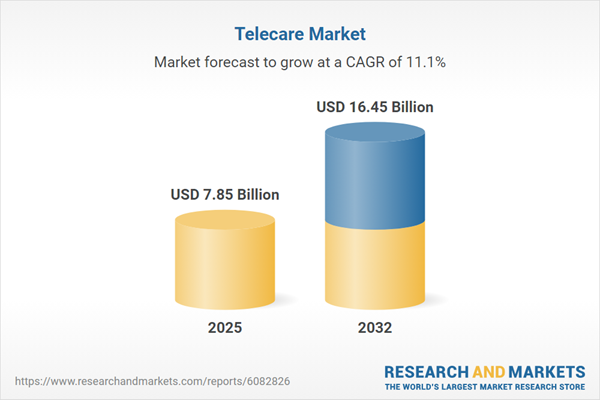Speak directly to the analyst to clarify any post sales queries you may have.
The telecare market is reshaping how organizations deliver remote health solutions, offering proactive, data-informed support and improving care transitions outside conventional clinical sites. Senior decision-makers now face expansive opportunities for strategic growth, operational efficiency, and value creation as digital health adoption accelerates.
Telecare Market Snapshot
The global telecare market grew from USD 7.07 billion in 2024 to USD 7.85 billion in 2025, with forecasts projecting further expansion at a CAGR of 11.12%, reaching an expected USD 16.45 billion by 2032. This momentum is primarily fueled by the integration of advanced sensor systems, advancements in artificial intelligence for analytics, and increasing requirements for flexible care delivery models beyond conventional healthcare environments. Leading providers are evolving their business strategies to address complex stakeholder needs across payer, provider, and user segments, while regional market growth trajectories are defined by infrastructure capability and evolving regulatory policies. For organizations, maintaining strategic agility remains essential to capture emerging opportunities in this dynamic market.
Scope & Segmentation
This report delivers an in-depth overview of all telecare segments, providing actionable guidance for senior leaders developing strong value propositions and market positioning:
- Product Types: Bed occupancy sensors, chair occupancy sensors, ambient and body-worn fall detectors, medication dispensers, motion sensors, smoke detectors, and personal emergency response systems (home stations and wearables), all supporting prompt intervention and safety in varied settings.
- End Users: Chronic disease patients, individuals with disabilities, and elderly care populations—reflecting increased demand for technologies that promote autonomy and long-term wellness management.
- Applications: Home monitoring, remote monitoring, and telemedicine integration that extend reach and enable organizations to coordinate care leveraging real-time insights.
- Technologies: Both wearable and non-wearable devices, supporting user flexibility and adaptability in diverse deployment scenarios.
- Connectivity Types: Wired and wireless solutions forming the foundational network for operational continuity and interoperability.
- Service Offerings: Installation, maintenance, and system monitoring services that sustain device performance and support user experience across the entire solution lifecycle.
- Geographical Coverage: Americas, Europe, Middle East, Africa, and Asia-Pacific, with focused analysis of high-growth healthcare markets, including China, India, Japan, Australia, and South Korea.
- Company Profiles: Major global providers such as Koninklijke Philips N.V., ADT Inc., Resideo Technologies, Inc., Honeywell International Inc., Bosch Healthcare Solutions GmbH, Tunstall Healthcare Group Ltd, Alarm.com Holdings, Inc., Medtronic plc, General Electric Company, and iRhythm Technologies, Inc., each shaping evolving regional strategies and driving innovation.
Key Takeaways
- The telecare market is transitioning beyond traditional alarm-based systems, with AI-enabled, integrated platforms enabling personalized, adaptive care pathways that better serve providers and patients.
- Customization of devices and solutions is growing, as organizations design offerings fit for chronic condition management and to enable greater independence among seniors and those requiring assisted living.
- Tech vendors, care providers, and telecom firms increasingly collaborate to accelerate deployment of connected solutions, resulting in more coordinated, data-driven workflows and enhanced service delivery.
- Regulatory and reimbursement environments are significantly influencing the pace of adoption, encouraging early incorporation of advanced monitoring technologies by providers and payers.
- The industry places heightened focus on intuitive interfaces and modular packages, aligned with shifting expectations from both consumers and institutions for simple, seamless integration.
- Diverse regional needs and adoption factors—especially across Asia-Pacific and EMEA—underscore the importance of tailored strategies, robust infrastructure, and sustained investment in local market assets.
Tariff Impact
Recent tariff measures in the United States directly affect telecare manufacturing costs and supply chain operations. In response, industry participants are reassessing sourcing, making targeted investments in domestic production, and refining device designs to address cost pressures. This landscape encourages innovation and regional manufacturing partnerships to ensure cost competitiveness and supply chain dependability.
Methodology & Data Sources
The research combines qualitative interviews with industry leaders and structured surveys of telecare solution users, complemented by extensive secondary analysis of regulatory filings, market reports, and proprietary datasets. Both top-down and bottom-up triangulation methodologies provide confidence in the reliability of insights presented.
Why This Report Matters
- Delivers actionable, sectioned intelligence to support strategic planning in healthcare and technology organizations pursuing opportunities within the telecare market.
- Enables leaders to proactively manage regulatory risks and investment choices, and to adapt operational models in a rapidly evolving landscape.
- Supports operational managers in evaluating expansion channels and aligning with changing market, technology, and consumer trends.
Conclusion
As digital health, supportive policy, and user-focused innovation converge, the telecare market stands on the cusp of structural change. Leaders embracing these insights are positioned to achieve sustainable advantage and deliver future-ready care solutions.
Table of Contents
3. Executive Summary
4. Market Overview
7. Cumulative Impact of Artificial Intelligence 2025
Companies Mentioned
The companies profiled in this Telecare market report include:- Koninklijke Philips N.V.
- ADT Inc.
- Resideo Technologies, Inc.
- Honeywell International Inc.
- Bosch Healthcare Solutions GmbH
- Tunstall Healthcare Group Ltd
- Alarm.com Holdings, Inc.
- Medtronic plc
- General Electric Company
- iRhythm Technologies, Inc.
Table Information
| Report Attribute | Details |
|---|---|
| No. of Pages | 195 |
| Published | October 2025 |
| Forecast Period | 2025 - 2032 |
| Estimated Market Value ( USD | $ 7.85 Billion |
| Forecasted Market Value ( USD | $ 16.45 Billion |
| Compound Annual Growth Rate | 11.1% |
| Regions Covered | Global |
| No. of Companies Mentioned | 11 |









